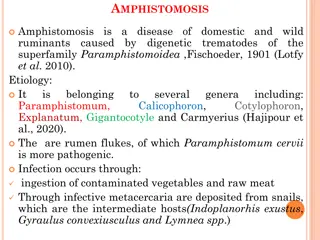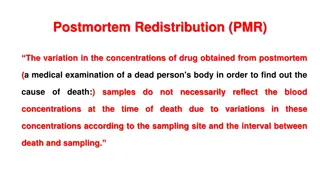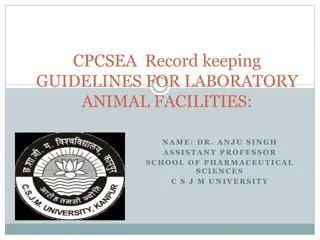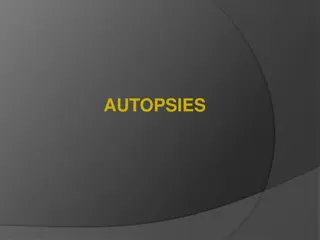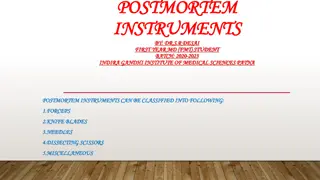Understanding Amphistomosis in Ruminants: Causes, Symptoms, and Diagnosis
Amphistomosis is a disease in ruminants caused by several types of rumen flukes. It leads to productivity losses, weight loss, fertility reduction, and other symptoms. Infection occurs through ingestion of contaminated vegetables and raw meat. The parasite affects the rumen and reticulum of sheep, g
0 views • 8 slides
Understanding Postmortem Redistribution in Forensic Toxicology
Postmortem Redistribution (PMR) refers to the variation in drug concentrations obtained from postmortem samples, which may not accurately reflect the levels at the time of death due to redistribution mechanisms. In forensic toxicology, assessing drug severity relies on blood concentrations, with cha
0 views • 16 slides
Postmortem Fingerprinting Techniques in Deceased Individuals
Postmortem fingerprinting is essential in cases where identification is challenging due to factors like mass disasters or decomposition. This process involves preliminary preparations, methods of recording fingerprints, and specific techniques for cadavers in different states, such as recent death o
0 views • 21 slides
Heat, Cold, & Electrical Trauma in Forensic Medicine Course
A detailed overview of a Forensic Medicine course focusing on heat, cold, and electrical trauma, including case scenarios, discussions on heat injuries, postmortem examinations of burn victims, and pugilistic attitude. References to relevant sources are provided for further study.
2 views • 5 slides
Guidelines for Recording Keeping in Laboratory Animal Facilities
The Committee for the Purpose of Control and Supervision of Experiments on Animals outlines the importance of maintaining detailed records in laboratory animal facilities to ensure the well-being and proper management of animals used in experiments. Records ranging from animal house plans, staff hea
4 views • 5 slides
The Role of a Coroner in Investigating Unnatural Deaths
The role of a coroner involves investigating deaths under specific circumstances, such as violent or unnatural deaths, unknown causes of death, or deaths in custody. This investigation includes notification, postmortem examinations, and possibly opening an inquest if required criteria are met. The c
0 views • 14 slides
Understanding Autopsies: Importance, Types, and Legal Significance
Autopsy, also known as necropsy or postmortem examination, is a vital procedure that provides valuable insights into the cause of death, diseases, hereditary conditions, and legal matters. This practice dates back to ancient civilizations like the Egyptians. By conducting autopsies, medical professi
0 views • 21 slides
Overview of Postmortem Instruments and Equipment
In this comprehensive guide, first-year MD student Dr. S.R. Desai classifies postmortem instruments into categories such as forceps, knife blades, needles, dissecting scissors, and miscellaneous items. The article delves into the functions of forceps and different types like toothed forceps, smooth
0 views • 30 slides
Enhancing Replay Interface Efficiency in System Debugging
Efforts by researchers at Microsoft Research Asia and MIT focus on enhancing replay interface efficiency for system debugging. The motivation stems from the non-determinism challenges caused by time, user input, network I/O, and thread interleaving. The study observes that only certain parts of a pr
0 views • 26 slides
Postmortem of Tale of Tales' The Path: A Little Red Riding Hood-inspired Video Game
In this postmortem analysis of The Path, a horror video game inspired by Little Red Riding Hood, the creators Michael Samyn and Auriea Harvey detail the history of the project from its inception in 1999 to its public launch in 2008. The game was intended to be short, non-linear, and focused on digit
0 views • 29 slides
Postmortem Care Simulation Workshop for Nurse Residents
Delve into the process and responsibilities of RNs in postmortem care through a thoughtful simulation workshop. Explore pronouncement of death, family notifications, organ donation, and more. Engage in discussions on emotions tied to providing postmortem care, providing a safe space for new nurses t
0 views • 6 slides
